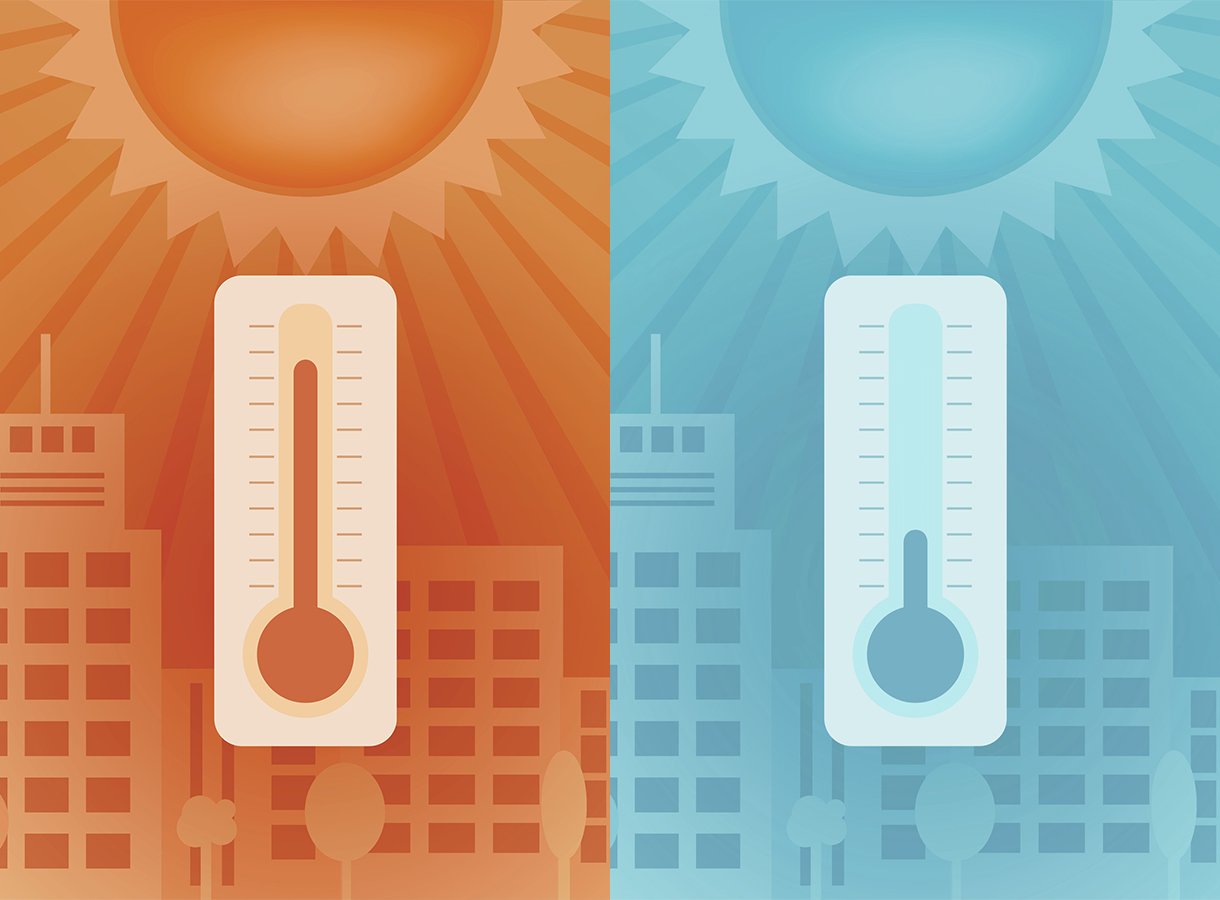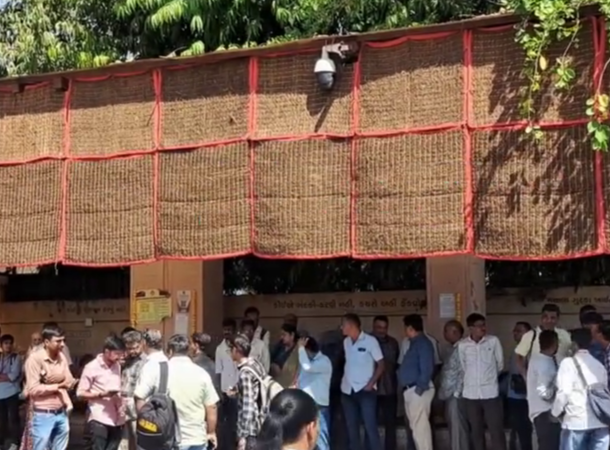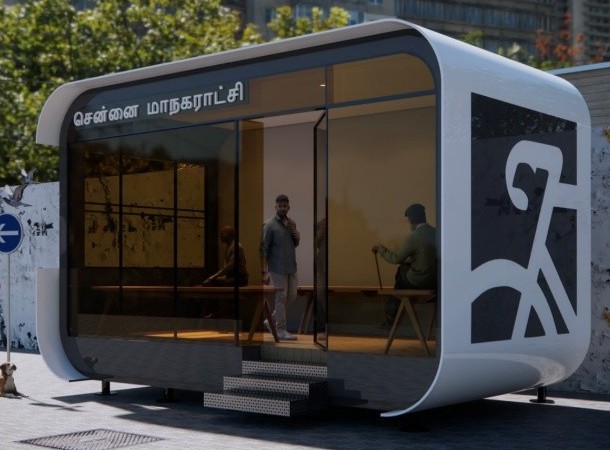
As climate change accelerates, cities across India are getting hotter and becoming more vulnerable to extreme heat waves. Staying cool isn’t just about comfort anymore — it’s becoming essential for our health, food systems, and economic activity. Right now, most of our cooling needs are met through active technologies like air conditioners. But this growing reliance comes at a cost. It’s fueling a vicious cycle: more cooling means more energy use and emissions, which drive climate change. And that, in turn, increases our need for cooling even more.
Our cities are heating up – not only due to climate change, but also because urban areas experience additional heat from the Urban Heat Island (UHI) effect. As a result, cities become significantly warmer than the nearby rural areas, sometimes by as much as 5°C, especially in certain climate zones. Why? As cities grow and urbanise rapidly, green spaces shrink, concrete and asphalt dominate, and heat from cars, factories, and air conditioners builds up. High-density buildings, restricted wind circulation, changing land use, and urban sprawl, all add to the problem. Together, these factors trap heat, make cities hotter, more uncomfortable, and increasingly vulnerable during heat waves.
It is clear that heating and cooling are deeply interconnected and must be addressed collectively.
Gaps in current policies
At the national level, India has made significant strides in developing heating and cooling policy frameworks. The India Cooling Action Plan (ICAP), for example, outlines sector-specific strategies for space cooling, cold chains, refrigerants, air conditioning in transport, and more. Institutions such as Bureau of Energy Efficiency (BEE) and the National Center for Cold-chain Development (NCCD) rate buildings and appliances for sustainability and energy efficiency. There is also the national guideline for Heat Action Plans (HAP) by the National Disaster Management Authority (NDMA) that guides the state, district and city planning on heat adaptation efforts.
A Heat Action Plan (HAP) devises strategies to adapt to the adverse effects of extreme heat. It incorporates early warning systems, preparedness efforts, and responsive actions to reduce the incidence of heat-related illnesses and fatalities. However, HAPs focus solely on short-term adaptation measures, with minimal emphasis on mitigation. They do not consider cooling interventions.
While the Climate Change Action Plan and the Energy Efficiency Action Plan address cooling by reducing GHG emissions and energy intensity, at the state and city levels, there are actually very few policies that directly address the cooling needs.
An approach to addressing cooling at the state and city level is observed in the form of cool roof policies, where several states have established specific targets to improve thermal comfort. Telangana, for instance, has a target of covering 300 sq km of area with cool roofs by 2029.
The result is a fragmented policy landscape, leading to missed opportunities, overlapping mandates, and critical gaps in coverage. Without a unified approach, cities struggle to implement effective and scalable solutions to address heating and cooling challenges. Further, many of the existing action plans lack any specificity regarding execution and fixing responsibilities.
As a result, implementation remains a significant weakness — targets are set without a road map, responsible agencies, or resource planning. Moreover, there is no city-level framework that comprehensively links space cooling, building codes, urban planning, and citizen health & well-being.
Why Cities Must Lead
Although national and state governments establish the overarching vision and policy framework, it is at the municipal level where the implementation takes place. Urban areas not only bear the brunt of climate impacts, but also serve as the primary arenas for planning, infrastructure development, and decisions that determine daily energy use.
Urban local bodies can regulate building design, promote cool roofs, retrofit infrastructure, and implement early warning systems for heat waves. They are also best placed to coordinate across sectors such as urban planning, housing, public health, water, and energy, all of which intersect in the heating-cooling nexus.
Cities are uniquely positioned to design and implement context-specific solutions. And we have observed this with the implementation of the current HAPs, as various cities in India are adopting innovative solutions as a part of their HAPs to support vulnerable groups affected by extreme heat.
For instance, the Ahmedabad Municipal Transport Service (AMTS), along with MHT, have launched India’s inaugural ‘Cool Bus Stop’, featuring a High-Pressure Mist System designed to alleviate rising temperatures and enhance commuter comfort. The Chennai Municipal Corporation is establishing air-conditioned rest areas for gig workers, one of the most vulnerable groups, who lack sufficient space for rest and safety amid the intensifying summer heat.
Despite concerns regarding the current framework of HAP, it is undeniable that the implementation of HAPs at the urban level has yielded positive results. However, without an integrated and actionable framework, cities lack the direction and resources to implement heating and cooling solutions effectively. The Integrated Heating and Cooling Action Plan (IHCAP), can develop on the shortcomings of the HAPs and act as the missing link in India’s climate response at the city level.


An Integrated Approach to Heating and Cooling
An IHCAP brings together all aspects of thermal comfort into one unified plan tailored to local conditions. By aligning adaptation and mitigation goals, defining clear roles, and laying out implementable strategies, IHCAPs help cities move from intention to action.
By integrating cooling and heating initiatives, cities can lower emissions from the cooling sector. Increasing blue-green infrastructure and prioritising energy-efficient and sustainable buildings will help lessen the demand for active cooling. Additionally, adopting innovative and efficient cooling systems such as district cooling, water-based chillers, not-in-kind technology, and high-star-rated ACS will further reduce energy demand intensity.
For instance, implementing a district cooling system offers numerous benefits. By integrating the cooling needs of multiple buildings, it lowers the capacity required for the cooling plant, enhances plant efficiency, and utilises natural refrigerants. This approach typically leads to a 25% reduction in annual energy demand, 40-80% decrease in peak power demand, and a 30-35% cut in greenhouse gas emissions.
With cities on the front lines of climate change, empowering them with a robust, integrated framework isn’t just smart policy — it’s a necessity for sustainable urban futures.
Rohit Bagai is a Senior Research Associate and Nidhi Bali is Director – Urban Transition at iFOREST
